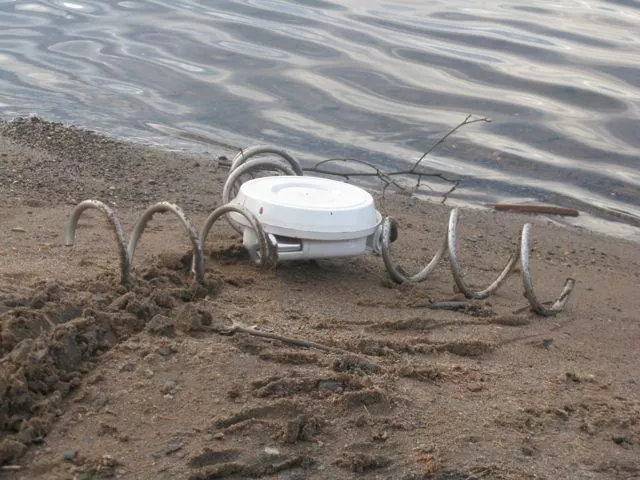Some day in the future, it's possible that an unmanned rover may go trundling across the Martian landscape not on wheels, but on three rotating steel coils. While able to traverse rugged terrain without getting stuck, it could also move sideways to get around obstacles, would be unlikely to malfunction as it would have very few moving parts, and could perhaps even remain mobile if it were to take a tumble and flip over. Although such a vehicle might not be exploring Mars any time particularly soon, a fully-functioning prototype does already exist here on Earth, and its design could find terrestrial applications.
The basic device
Wisconsin engineer Tim Lexen built and designed the rover. At its heart is a flat triangular PVC main body (measuring about 7 inches/17.8 cm per side) that houses three electric servo motors, battery packs, and electronics. These independently power its three 8-inch (20.3-cm) stainless steel helical coils, also known as screws, each one extending horizontally from one corner of its body. The screws incorporate a low-friction outer coating that keeps them from getting stuck against rough surfaces while their augering action allows them to push or pull against those surfaces to move the rover in any desired direction. For this reason, it works best on textured surfaces such as dirt, grass, sand, or gravel, as opposed to completely flat, smooth surfaces.The proof-of-concept device is remotely-piloted by a human operator, via a standard hobbyist's radio-control system.

Predecessors
Screw-driven ground vehicles in and of themselves are certainly nothing new, having been around since at least the 1860s - one relatively well-known example is the Russian ZIL off-road vehicle. Almost all of these, however, have utilized pairs of longitudinally-mounted pontoons with sharp-edged augers coiling around their outer surfaces. While these did a decent job of moving the vehicles forward over rough or sloppy terrain, they required the vehicles to face whatever direction they were turning. The Y-layout and rounded edges of the screws on Lexen's rover, by contrast, allows for complete omnidirectional (or holonomic) drive - this means it can move in any direction, without having to turn to face that direction itself. This could be particularly useful when trying to get around obstacles in tight quarters. While a typical wheeled vehicle would need room to move forward or backward in order to perform its arcing turns, the rover could simply stop at obstacles, then execute sideways right-angle "turns" while still facing the same direction.
It should be noted that some indoor wheeled vehicles are also able to achieve holonomic motion via independently-swiveling caster-like wheels, but Lexen believes that these would not work well on uneven terrain.

Staying versatile
Although the rover can maintain its orientation regardless of what direction it's moving, it can also change that orientation as needed. In order to avoid tipping forward when going down a steep incline, for instance, it could swivel around so that it had one screw extended directly in front. When approaching a small hole, however, it could be swiveled to straddle that hole with two outward-angled screws on either side, instead of nose-diving into it with just one. "This design should be suitable for outdoor rover applications requiring high maneuverability, robustness, reliability, and resistance to getting stuck or trapped," Lexen told Gizmag. "It has an absolute minimum of moving parts, no suspension, no mechanisms; is it less complex, by roughly an order of magnitude, than any other outdoor rover chassis design, not to mention any outdoor holonomic design."
Below is a video that Tim posted for us, which shows his device in action:
Via New Scientist.







